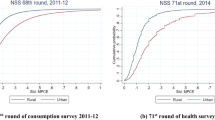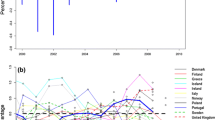Abstract
This article deals with the accuracy of statistical records used for political decision making and international comparative analysis. In developing countries, even major macroeconomic indicators can include data inadequacies and methodological differences in data generation between statistical agencies. Existing data show that total health expenditure as a percentage of GDP is about 50% lower in Pakistan than in other low-income countries (LIC). To determine whether these results reflect the actual situation in Pakistan or whether they are due to statistical error, Pakistan produced National Health Accounts (NHA) for the first time in 2009 to assess health spending in 2005–6. Improved NHA estimates are also being made for 2007–8, which will be based on the following: public expenditure data published with time lags; survey results for 2007–8; and multivariate analyses of data from 2010 and 2011 surveys on health-specific out-of-pocket (OOP) expenditure, healthcare providers, non-profit institutions and census data on autonomous bodies and large hospitals.
Since these data are not yet available, a best estimate of health expenditure has to be made to support policy decision making and to provide a point of comparison for future NHA results. Health expenditure data are available from different data sources and estimates have been made by applying different methods, leading to a range of health spending estimates. As a result of this diversity of estimates and data, each with its own inaccuracies or gaps, there was a clear need to triangulate the available information and to identify a best possible estimate.
This article compares estimates of household health expenditure from different sources, such as the Household Integrated Economic Survey, the Family Budget Survey and National Accounts (NA). The analysis shows that health expenditure figures for Pakistan have been underestimated by both WHO and the NHA. An adjusted estimate shows OOP spending to be twice as high as previously thought. Previous per capita total health expenditure estimates ranged from $US16 to $US19. The revised estimate showed per capita total health expenditure to be $US33, based on NA data. This puts Pakistan in a different position in international comparisons, with health expenditure exceeding the level of India ($US32.5) and the average of all LIC ($US24.5).
Methodological differences in estimating expenditure and the multiple and conflicting estimates might cause stakeholders to make potentially adverse or even erroneous policy decisions on the allocation of resources. Because policy makers make decisions based on the estimates provided, the provision of a best estimate, made following a review of the advantages and limitations of existing sources and methods, is key.








Similar content being viewed by others
Notes
1 The WHO THE figure is the average of figures for the 2005 and 2006 calendar years, $US15 and $US16, respectively.
2 This distinction of levels can be confusing, particularly in determining who finances health in a country. One solution might be the usage of an underlying matrix that shows the flow from ‘original sources’ to ‘financing sources’ (OS × FS). Such a system of underlying matrices would allow one to indicate flows from original sources such as private companies, governmental institutions and the corporate sector (salaries) to the financing source ‘households’ (employees). This system could have several layers of sub-matrices. Related to health expenditure, the flows from original sources such as collected taxes and donors’ financial budget aid to the financing source (finance ministry) could be shown in an OS × FS matrix.
3 The same post-adjustments have now been published by WHO under Pakistan country information in the accounts section (see WHO[1] ).
4 Code 5601 includes medicines and vitamins, medical apparatus and other equipment/supplies, etc.
5 Code 5602 includes medical fees paid to doctors, specialists, Hakeem (traditional healer) or midwives outside hospital (including medicines prescribed, etc.); hospitalization charges (including fees, for example, for doctors or Hakeem, etc.); and laboratory tests, x-ray charges, dental care, teeth cleaning, extraction, eye glasses and all other charges not classified elsewhere.
6 The original WHO estimate was 98.2% for 2000 and 98.0% for 2005. The official NHA figure is 99.7% (comparable). In the adjusted WHS from 2010, the OOP share is estimated at 80.3% for 2000 and 82.1% for 2007 without mentioning any reason for the change, since the share of private health insurance is still relatively low in Pakistan.
7 The estimated figure including urban and rural households in HIES leads to a THE estimate of PKR121.823 billion.
9 The FBS is only conducted for some urban areas; in contrast, the HIES covers urban and rural areas all over Pakistan. To make the two results comparable for private health expenditure on a national level, we used only the HIES urban data, assuming that these figures are higher than those for rural areas
References
WHO. WHO estimates for national health accounts data: Pakistan [online]. Available from URL: http://www.who.int/nha/country/pak/en/ [Accessed 2011 Oct 08]
WHO. World health survey 2005. Geneva: WHO, 2008 [online]. Available from URL: http://www.who.int/healthinfo/survey/whspak-pakistan.pdf [Accessed 2011 Oct 08]
World Health Organization. World health statistics 2007. Geneva: WHO, 2007 [online]. Available from URL: http://www.who.int/entity/whosis/whostat2007.pdf [Accessed 2011 Oct 04]
Federal Bureau of Statistics. Pakistan Statistical Year Book 2007. Islamabad: FBS, 2007 [online]. Available from URL: http://www.statpak.gov.pk/fbs/content/pakistan-statistical-year-book-2007 [Accessed 2011 Oct 04]
WHO. Guide to producing national health accounts with special applications for low-income and middle-income countries. Geneva: WHO, 2003 [online]. Available from URL: http://www.who.int/nha/docs/English_PG.pdf [Accessed 2011 Oct 08]
Lorenz C, Richter A. Health and family planning in Pakistan by income and regional population groups. Pakistan J Med Health Sci 2009 Oct–Dec; 2(4): 365–75
Nishtar S. Devolving health [online]. Available from URL: http://www.heartfile.org/pdf/104_Devolving_health_Part2.pdf [Accessed 2011 Oct 04]
De S, Dmytraczenko T, Brinkerhoff D, et al. Has improved availability of health expenditure data contributed to evidence-based policymaking? Country experiences with national health accounts. Bethesda (MD): PHRPlus, 2003 [online]. Available from URL: http://pdf.usaid.gov/pdf_docs/Pnacu809.pdf [Accessed 2011 Oct 08]
Ministry of Health. National health policy: stepping towards better health. Pakistan: Ministry of Health, 2009 [online]. Available from URL: http://www.healthnwfp.gov.pk/downloads/draft%20health%20policy.pdf [Accessed 2011 Oct 04]
World Health Organization. Estimates for country NHA data [online]. Available from URL: http://apps.who.int/nha/database/StandardReport.aspx?ID=REP_WEB_MINI_TEMPLATE_WEB_VERSION&COUNTRYKEY=84701 [Accessed 2011 Oct 04]
Metzger P, Baloch NA, Kazil GN, et al. Tuberculosis control in Pakistan: reviewing a decade of success and challenges. East Mediterr Health J 2010; 16 Suppl. [online]. Available from URL: http://www.emro.who.int/publications/emhj/16_Supp/article6.htm [Accessed 2011 Oct 20]
Sabih F, Bile KM, Buehler W, et al. Implementing the district health system in the framework of primary health care in Pakistan: can the evolving reforms enhance the pace towards the Millennium Development Goals? East Mediterr Health J 2010; 16 Suppl. [online]. Available from URL: http://www.hsa.edu.pk/faculty/PHC%20in%20Pakistan%20EMRO.pdf [Accessed 2011 Oct 20]
Pakistan Health Economics Network (PHEN). Landscaping health financing works in Pakistan: report. Eastern Mediterranean Regional Office: World Health Organization, 2010 [online]. Available from URL: http://hsa.edu.pk/academics/HE%20landscaping%20report_final%20_4_.pdf, [Accessed 2011 Oct 04]
Nishtar S. Health and the 18th amendment: retaining national functions in devolution, 2011 [online]. Available from URL: http://www.heartfile.org/pdf/HEALTH_18AM_FINAL.pdf [Accessed 2011 Oct 04]
Sarfraz M. Pakistan profile of the sexual and reproductive health services available at primary care level. Islamabad: Health Service Academy [online]. Available from URL: http://www.gfmer.ch/SRH-Course-2011/assignments/A2/pdf/A2-091-Sarfraz-Mariyam.pdf [Accessed 2011 Oct 20]
Malik MA. National health accounts: lessons for Pakistan. J Pak Med Assoc 2009; 59(10): 712–16 [online]. Available from URL: http://www.jpma.org.pk/full_article_text.php?article_id=1832 [Accessed 2011 Oct 04]
Nishtar S. Choked pipes: reforming Pakistan’s mixed health system. Karachi: Oxford University Press, 2010
Pakistan Health Policy Forum, Heartfile, Department of Health NWFP, Transparancy International. Pakistan’s health sector: does corruption lurk? Islamabad: Heartfile, 2007 [online]. Available from URL: http://www.heartfile.org/pdf/health-sector-corruption-pakistan.pdf [Accessed 2011 Oct 08]
Akram M, Khan FJ. Health care services and government spending in Pakistan. Islamabad: Pakistan Institute of Development Economics, 2007 [online] Available from URL: http://ideas.repec.org/p/pid/wpaper/200732.html [Accessed 2011 Oct 04]
World Health Organization. Strategy on health care financing [online]. Available from URL: http://203.90.70.117/PDS_DOCS/B0131.pdf [Accessed 2011 Oct 20]
World Health Organization. World health statistics 2008. Geneva: WHO, 2008 [online]. Available from URL: http://www.who.int/whosis/whostat/2008/en/ [Accessed 2011 Oct 20]
Federal Bureau of Statistics. National Health Accounts Pakistan 2005–6, Islamabad [online]. Available from URL: http://www.statpak.gov.pk/fbs/sites/default/files/national_accounts/national%20health%20accounts/National_Health_Accounts.pdf [Accessed 2011 Oct 20]
WHO. The world health report 2008. Geneva: WHO, 2008 [online]. Available from URL: http://www.who.int/whr/2008/en/index.html [Accessed 2011 Oct 08]
Department of Economic and Social Affairs. World Statistics Pocketbook 2007. New York: United Nations, 2008 [online]. Available from URL: http://unstats.un.org/unsd/pocketbook/Pocketbook%202007.pdf [Accessed 2011 Oct 20]
World Health Organization. World health statistics 2009. Geneva: WHO, 2009 [online]. Available from URL: http://www.who.int/whosis/whostat/EN_WHS09_Full.pdf [Accessed 2011 Oct 20]
Struck B. National health accounts: definitions and treatment of social security within this accounting framework [presentation]. Dissemination of Social Health Protection and National Health Accounts for Key Policy and Decision Makers; 2009 May 7; Islamabad
World Health Organization. Global health expenditure database: table of key indicators and sources by country [online]. Available from URL: http://apps.who.int/nha/database/StandardReport.aspx?ID=REP_WEB_MINI_TEMPLATE_WEB_VERSION&COUNTRYKEY=84701 Accessed 2011 Oct 20]
Lorenz C. Out-of-pocket household health expenditures and their use in national health accounts: evidence from Pakistan. Asia Health Policy Program: working paper series [working paper no. 9]. Stanford (CA): Stanford University, 2010 [online]. Available from URL: http://iis-db.stanford.edu/pubs/22555/lAHPPwp9.pdf [Accessed 2011 Oct 08]
Lorenz C. Health expenditures in Pakistan: cross-checking household expenditure data on health for NHA and adjustment with national accounts [working paper no. 14]. Asia Health Policy Program: working paper series. Stanford (CA): Stanford University, 2010 [online]. Available from URL: http://iis-db.stanford.edu/pubs/22930/AHPPwp14.pdf [Accessed 2011 Oct 08]
World Health Organization. World health statistics 2010. Geneva: WHO, 2010 [online]. Available from URL: http://www.who.int/whosis/whostat/EN_WHS10_Full.pdf [Accessed 2011 Oct 20]
Rannan-Eliya RP. Estimating out-of-pocket spending for national health accounts. Geneva: World Health Organization, 2010 [online]. Available from URL: http://www.who.int/nha/methods/estimating_OOPs_ravi_final.pdf [Accessed 2011 Oct 20]
Whitehead M, Dahlgren G, Evans T. Equity and health sector reforms: can low-income countries escape the medical poverty trap? Lancet 2001; 358(9284): 833–6
Van Doorslaer E. Paying out-of-pocket for health care in Asia: catastrophic and poverty impact (EQUITAP project). Working Papers, 2007 [online]. Available from URL: http://www.equitap.org/publications/docs/EquitapWP2.pdf [Accessed 2011 Oct 08]
Rannan-Eliya RP. National health accounts estimation methods: household out-of-pocket spending in private expenditure [draft monograph]. Geneva: WHO, 2008
Federal Bureau of Statistics. Household integrated economic survey (HIES) 2005–06. Islamabad: FBS, 2007 [online]. Available from URL: http://www.statpak.gov.pk/fbs/content/household-integrated-economic-survey-hies-2005-06 [Accessed 2011 Oct 20]
Federal Bureau of Statistics. Family Budget Survey 2007/8. Islamabad: FBS, 2009
Ministry of Finance. Pakistan economic survey 2007/08 [online]. Available from URL: http://www.finance.gov.pk/survey_0708.html [Accessed 2011 Oct 20]
Federal Bureau of Statistics. National Accounts: GNP of Pakistan (at current factor costs) [online]. FBS: Islamabad, 2009 [online]. Available from URL: http://www.statpak.gov.pk/fbs/sites/default/files/national_accounts/tables/table4.pdf [Accessed 2011 Oct 08]
Federal Bureau of Statistics. National Accounts: expenditure on GNP at current prices — general government current consumption expenditure. FBS: Islamabad, 2009 [online]. Available from URL: http://www.statpak.gov.pk/fbs/sites/default/files/national_accounts/tables/table8.pdf [Accessed 2011 Oct 08]
Federal Bureau of Statistics. National Accounts: expenditure on GNP at current prices — private consumption expenditure. FBS: Islamabad, 2009 [online]. Available from URL: http://www.statpak.gov.pk/fbs/sites/default/files/national_accounts/tables/table8.pdf [Accessed 2011 Oct 08]
Federal Bureau of Statistics. National Accounts: exposition of methodology, 15. Islamabad: FBS, 2011 [online]. Available from URL: http://www.statpak.gov.pk/fbs/sites/default/files/national_accounts/methodology/methodology_new1.1.pdf [Accessed 2011 Oct 08]
Federal Bureau of Statistics. First national health accounts for Pakistan released. Islamabad: FBS, 2009 [online]. Available from URL: http://www.statpak.gov.pk/depts/fbs/publications/publications.html [Accessed 2011 Feb 01]
Acknowledgements
The author thanks Bernd Struck and Melissa Hein for their useful remarks.
No sources of funding were used to conduct this study or prepare this manuscript. The author has no conflicts of interest that are directly relevant to the content of this article. The opinions expressed in this manuscript are the author’s own.
Author information
Authors and Affiliations
Corresponding author
Rights and permissions
About this article
Cite this article
Lorenz, C. Triangulating health expenditure estimates from different data sources in developing countries. Appl Health Econ Health Policy 10, 1–13 (2012). https://doi.org/10.2165/11595230-000000000-00000
Published:
Issue Date:
DOI: https://doi.org/10.2165/11595230-000000000-00000




